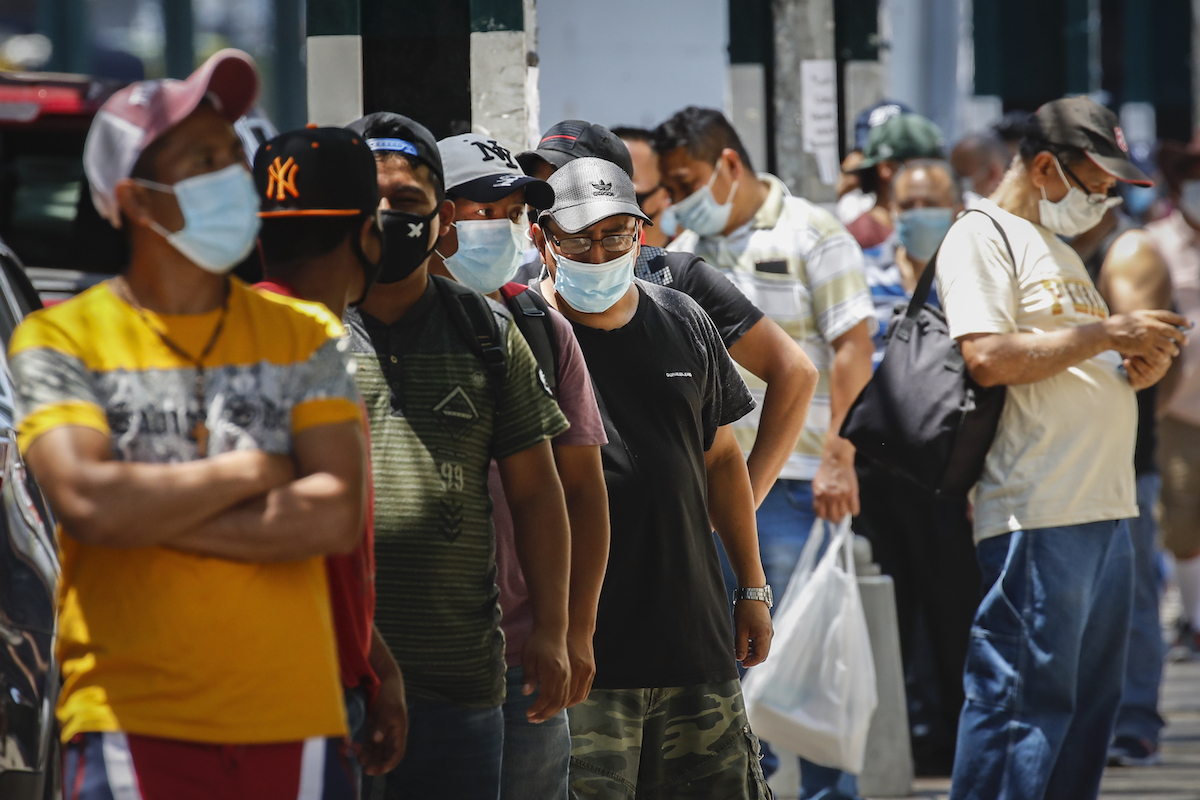

In this June 23, 2020 file, pedestrians wearing protective masks wait in line for food donations during the COVID-19 pandemic in the Corona neighborhood of the Queens borough of New York. (AP Photo/John Minchillo)
Our neglect of the poor has become a tinder box and COVID-19 could be the spark that starts a deadly conflagration.
As the pandemic becomes less and less uncontrollable, some consistent facts remain: The virus is highly contagious, easily transmittable, potentially lethal and has a negative effect on our health care system. Even though there is currently no cure, it is to some degree preventable by maintaining social distance, avoiding large crowds and wearing face coverings.
The virus does not target specific groups. However, another fact remains: The poor and elderly are the most vulnerable, and therefore suffer the most infections and deaths. As many elderly people are on fixed incomes, they too are often living at or below the poverty line. Simply put, COVID-19 and poverty are a lethal combination.
For generations we have been able to hide our vulnerabilities by looking the other way as increased health care costs and poverty systematically affects the most vulnerable in our society. Poverty has always been there, but it has never been as lethal as it is now considering current circumstances.
The poor are often criticized for not taking care of themselves. Preventative health care, including good nutrition, is a challenge when in constant survival mode. When struggling to make ends meet at the most basic levels —food, water and shelter— health care is only addressed in emergency situations.
What many take for granted —such as the basics— are difficult realties for those on the poverty line and below. Crowded living quarters, less than adequate sanitary conditions, inexpensive low-quality food and no access to preventative health care are staples for this population.
Our neglect of the poor has become a tinder box and COVID could be the spark that starts a deadly conflagration. Certain low-income population centers are at particular risk. The Navajo Nation in Arizona, migrant workers in border towns in Texas, agricultural workers in the Imperial Valley of California and the Rio Grande region, poorer areas of New York, Atlanta, Miami and Los Angeles all force people into close quarters while working and living. The vast majority are people of color, but poor whites suffer too.
Facilities that overwhelmingly house poor people such as jails, prisons, correctional facilities and immigrations detention centers can be added to the list of places ready to explode from COVID-19. These locations are de facto concentration camps of disease and poverty. They are inescapable areas in which survival activities such as work, are now putting these populations at greater risk.
Social neglect and isolation lead to chronic traps that lead to systemic circular helplessness. This produces shorter life spans, and chronic systemic illnesses. Systemic neglect of this poverty is coming back to haunt all of us by overwhelming our fragile healthcare system.
The evident lack of leadership from local, state and federal governments has created an environment where poor people have become even more marginalized and placed in a situation where they are particularly vulnerable to COVID-19.
Leadership means guidance and empathic assertiveness. It requires that a leader be emotionally able to put him or herself in the shoes of the most vulnerable and provide assertive options that will benefit the most. Politicians often are able to do this.
Even if their primary motivation is not the well-being of the people they represent, if the end result is better public healthy, then that is at least an acceptable option. We don’t need pure motivations. We need assertive guidance based on facts.
Our current environment of a patch-like approach to the pandemic has been a total failure. Examples from all parts of the world show us that. However, many of those societies are not “free” as are we. They do have more rigid cultures, strict rules, tough enforcement and even obtrusive surveillance.
It is exactly this sense of individuality and freedom that mandates good leadership and a unifying message based on science and data. Social distance. Wear a mask. These and other advice, if communicated by a trusted member of our government, would go a long way.
Leadership also means relaxing the pathways to economic opportunities that have been systematically developed specifically to limit minorities access to social and economic growth. Instead of tightening the grip on policies that are intended to maintain and perpetuate economic and social disadvantage, allow these communities to obtain more opportunities and economic freedom so that they may better support their own.
To those society members stuck in these areas, stay safe. Social distance as much as you can. Do wear masks. Help one another. Listen to trusted sources of information such as the CDC. If you do get sick, do your best to isolate so that you do not spread the virus to others.
***
Dr. Lauro Amezcua-Patino is the clinical voice of The Only You (Solo Tú), a podcast dedicated to simplifying the complex issues of the mind and mental illness. Originally from Mexico, Dr. Amezcua-Patino has been practicing in the metropolitan Phoenix area for over 30 years. Twitter: @SuSaludMental.


